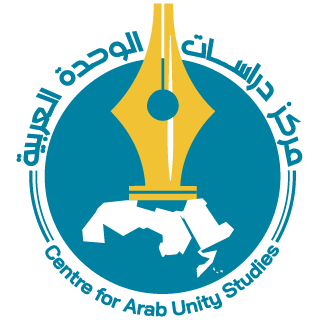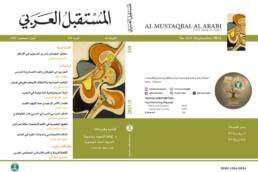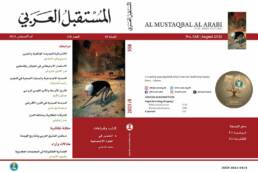المصادر:
(*) نُشرت هذه الدراسة في مجلة المستقبل العربي العدد 444.
(**) يوسف خليفة اليوسف: أستاذ اقتصاد سابق، جامعة الإمارات العربية المتحدة، والمشرف الحالي على موقع «دار السلام».
البريد الإلكتروني: subhana@emirates.net.ae
[1] Frauke Heard-Bey, From Trucial States to United Arab Emirates (London: Motivate Publishing, 2004), p. 337.
[2] رياض نجيب الريس، صراع الواحات والنفط: هموم الخليج العربي بين 1968 – 1971 (بيروت: رياض الريس للكتب والنشر، 2004)، ص 37 – 38 و91 – 117.
[3] يوسف خليفة اليوسف، الإمارات العربية المتحدة على مفترق طرق (بيروت: مركز دراسات الوحدة العربية، 2013)، ص 63 – 87.
[4] سيف بن عبود البدواوي، مجلس حكام الإمارات المتصالحة (رأس الخيمة، الإمارات العربية المتحدة: مركز الدراسات والوثائق، 2009)، ص 101 – 102.
[5] Malcom C. Peck, The United Arab Emirates: Aventure in Unity (Boulder, CO: Westview Press, 1986), pp. 44-46.
[6] Dani Rodrik, Arvind Subramanian and Francesco Trebbi, «Institutions Rule: The Primacy of Institutions over Geography and Integration in Economic Development,» Journal of Economic Growth, vol. 9, no. 2 (June 2004), pp. 131-165.
[7] Ginluca Paolo Parolin, «Generations of Gulf Constitutions: Paths and Perspectives,» in: Abdulhadi Khalaf and Gacomo Luciani, eds., Constitutional Reform and Political Participation in the Gulf (Dubai: Gulf Research Center, 2006), pp. 57-58.
[8] Frauke Herd-Bey, «The UAE: A Quarter Century of Federation,» in: Michel Hudson, ed., Middle East Dilemma: The Politics and Economics of Arab Integration (London: I. B. Tauris, 1999), pp. 137-138.
[9] يحيى الجمل، «الدستور وسيلة للتكامل في دولة الإمارات العربية المتحدة،» ورقة قدمت إلى: التجارب الوحدوية العربية المعاصرة: تجربة دولة الإمارات العربية المتحدة: بحوث ومناقشات الندوة الفكرية التي نظّمها مركز دراسات الوحدة العربية، ط 4 (بيروت: المركز، 1999)، ص 584.
[10] Samuel P. Huntington, Political Order in Changing Societies (New Haven, CT; London: Yale University Press, 1968), p. 140.
[11] يوسف خليفة اليوسف، مجلس التعاون الخليجي في مثلث الوراثة والنفط والقوى الأجنبية، ط 2 (بيروت: مركز دراسات الوحدة العربية، 2014)، ص 348 – 350.
[12] International Monetary Fund [IMF], «Economic Diversification in the GCC: Past, Present, and Future,» prepared by Tim Callen [et al.] (December 2014), p. 13, <https://www.imf.org/external/pubs/ft/sdn/2014/sdn1412.pdf>.
[13] اليوسف، الإمارات العربية المتحدة على مفترق طرق، ص 203 – 212.
[14] Martin Hvidt, «Economic Diversification in GCC Countries: Past Record and Future Trends,» London School of Economics, no. 27 (January 2013), p. 13, <http://www.lse.ac.uk/middleEastCentre/kuwait/documents/Economic-diversification-in-the-GCC-countries.pdf>.
[15] عمر هشام الشهابي، اقتلاع الجذور: المشاريع العقارية وتفاقم الخلل السكاني في مجلس التعاون لدول الخليج العربية، ط 2 (بيروت: مركز دراسات الوحدة العربية، 2014)، ص 100.
[16] IMF, «Economic Diversification in the GCC: Past, Present, and Future,» pp. 13-14.
[17] Lisa W. Foderaro, «N.Y.U Abu Dhabi Scours Globe for Top Students,» New York Times, 20/6/2010.
[18] مقابلة حول كتاب علي خليفة الكواري، الشعب يريد الإصلاح في قطر… أيضاً، تنسيق وتحرير علي خليفة الكواري، ط 2 (بيروت: منتدى المعارف، 2014)، ص 55.
[19] Bertrand Gruss, «After the Boom-Commodity Prices and Economic Growth in Latin America and the Caribbean,» in: Regional Economic Outlook: Western Hemisphere: Rising Challenges (Washington, DC: International Monetary Fund, 2014).
[20] Hvidt, «Economic Diversification in GCC Countries: Past Record and Future Trends,» p. 13.
[21] التقرير الاقتصادي السنوي 2011، وزارة الاقتصاد والتجارة، الجدول الرقم (17)، ص 30.
[22] Hvidt, Ibid., p. 13.
[23] International Monetary Fund [IMF], United Arab Emirates: Selected Issues and Statistical Annex, Country Report no.12/136 (Washington, DC: IMF, 2012), p. 29.
[24] Hvidt, Ibid., p. 16.
[25] اليوسف، الإمارات العربية المتحدة على مفترق طرق، ص 263 – 286.
[26] Michael Herb, The Wages of Oil: Parliaments and Economic Development in Kuwait and the UAE (Ithaca, CA; London: Cornell University Press, 2014), pp. 113-116, and Ashfaq Ahmed, «Expats Make Up 99% of Private Sector Staff in UAE,» Gulf News, 7/4/2008.
[27] Robert Ditcham, «Emiratization Needs Private Sector to Succeed, Says Lumna,» Gulf News, 8/6/2006, <http://gulfnews.com/business/economy/emiratization-needs-private-sector-to-succeed-says-lubna-1.240001>.
[28] محمد هلال الخليفي، «الخلل السكانية.. من يوقف كرة الثلج؟!،» في: الشعب يريد الإصلاح في قطر… أيضاً، ص 347.
[29] International Monetary Fund [IMF], «Labor Market Reforms to Boost Employment and Productivity in the GCC,» prepared by Staff of the International Monetary Fund (5 October 2013), p. 8, <http://www.imf.org/external/np/pp/eng/2013/100513.pdf>.
[30] الشهابي، اقتلاع الجذور: المشاريع العقارية وتفاقم الخلل السكاني في مجلس التعاون لدول الخليج العربية، ص 29.
[31] المصدر نفسه، ص 111 و128.
[32] المصدر نفسه، ص 92.
[33] المصدر نفسه، ص 18.
[34] اليوسف، الإمارات العربية المتحدة على مفترق طرق، ص 252 – 263.
[35] United Arab Emirates: Statistical Appendix, IMF (October 2007), table 5 and (April 2009), table 3.
[36] Ibid, table 3.
[37] إبراهيم شريف السيد، «تأثيرات الطفرة النفطية الثالثة في البحرين،» في: إبراهيم شريف السيد [وآخرون]، الطفرة النفطية الثالثة وانعكاسات الأزمة المالية: حالة أقطار مجلس التعاون لدول الخليج العربية، تنسيق وتحرير علي خليفة الكواري (بيروت: مركز دراسات الوحدة العربية، 2009)، ص 195 – 198.
[38] اليوسف، الإمارات العربية المتحدة على مفترق طرق، ص 178 – 182.
[39] The National (27 June 2010).
[40] Reuters (6 July 2011).
[41] Christopher M. Davidson, After the Sheikhs: The Coming Collapse of Monarchies (London: Hurst and Company, 2012), p. 130.
[42] انظر: Simeon Kerr and Pilita Clark, «UAE Drops Fuel Subsidies to Boost Finances and Cut Emissions,» Financial Times, 22/7/2015, <http://www.ft.com/cms/s/0/18246646-3050-11e5-91ac-a5e17d9b4cff.html>.
[43] يوسف خليفة اليوسف، «دراسة حالة الإمارات العربية المتحدة،» ورقة قدّمت إلى: الفساد والحكم الصالح في البلاد العربية: بحوث ومناقشات الندوة الفكرية التي نظّمها مركز دراسات الوحدة العربية بالتعاون مع المعهد السويدي بالإسكندرية (بيروت: مركز دراسات الوحدة العربية، 2004)، ص 586.
[44] المصدر نفسه، ص 577 – 607.
[45] علي خليفة الكواري، «الطفرة النفطية الثالثة: قراءة أولية في دواعي الطفرة وحجمها: حالة أقطار مجلس التعاون،» المستقبل العربي، السنة 31، العدد 362 (نيسان/أبريل 2009)، ص 37 – 40.
[46] اليوسف، مجلس التعاون الخليجي في مثلث الوراثة والنفط والقوى الأجنبية، ص 84 – 87.
[47] F. Gregory Gause, III, Oil Monarchies: Domestic and Security Challenges in the Arab Gulf States (New York: Council on Foreign Relations Press, 1994), p. 58.
[48] يوسف خليفة اليوسف، الاقتصاد السياسي للنفط: رؤية عربية لتطوراته (بيروت: مركز دراسات الوحدة العربية، 2015)، ص 382.
[49] Onn Winckler, Arab Political Domography: Population Growth, Labor Migration and Natalist Policies, 2nd ed. (Brighton: Sussex Academic Press, 2009), pp. 17 and 37-38.
[50] Andrzej Kapiszewsji, National and Expatriates: Population and Labour Dilemmas (Reading, UK: Ithaca Press, 2001), pp. 27-28.
[51] اليوسف، الاقتصاد السياسي للنفط: رؤية عربية لتطوراته، ص 448 – 453.
[52] Martin Hvidt, «The Dubai Model: An Outline of Key Development –Process Elements in Dubai,» International Journal of Middle East Studies, vol. 41, no. 3 (August 2009), p. 407.
[53] Brad W. Setser and Rachel Ziemba, «GCC Sovereign Funds: Reversal of Fortune,» Council on Foreign Relations Center for Geo-Economics Studies, Working Paper (January 2009), p. 21.
[54] Edward Burke and Sara Bazoobandi, «The Gulf Takes Charge: The GCC in the MENA Region,» in: Richard Younges, ed., The GCC in the Global Economy, vol. 2 (London: Gerlach Press, 2012), p. 31.
[55] SWF (Sovereign Wealth Fund) Institute, «Sovereign Wealth Fund Rankings 2011,» (2012), <http://www.swfinstitute.org/fund/-rankings> (accessed on 31 January 2012).
[56] اليوسف، الإمارات العربية المتحدة على مفترق طرق، ص 203 – 218.
[57] مشاري عبد الله النعيم، «المدينة في الخليج العربي بين الطفرة النفطية والأزمة المالية: حالة دبي والمتشبهات بها،» في: السيد [وآخرون]، الطفرة النفطية الثالثة وانعكاسات الأزمة المالية: حالة أقطار مجلس التعاون لدول الخليج العربية، ص 310.
[58] <http://data.worldbank.org/indicator/NY.GDP.PCAP.CD>.
[59] اليوسف، الإمارات العربية المتحدة على مفترق طرق، ص 203 – 207.
[60] انظر: «Ethnic Composition,» <http://app.singapore.sg/society/our-people/ethnic-composition>.
[61] Christopher Davidson, «The Dubai Model Diversification and Slowdown,» in: Mehran Kamrava, ed., The Political Economy of the Persian Gulf (New York: Columbia University Press, 2012), pp. 213‑217.
[62] Lee Kuan Yew, From Third World to First: The Singapore Story: 1965-2000 (New York: Harper Collins Publishers, 2000), pp.157-171.
[63] «Why Does Singapore Top So Many Tables?,» BBC, 23 October 2013, <http://www.bbc.com/news/world-asia-24428567>.
[64] يوسف خليفة اليوسف، «عندما تصبح السلطة غنيمة،» المستقبل العربي، السنة 31، العدد 351 (أيار/مايو 2008)، ص 70 – 87.
[65] Jean-Pierre Filiu, From Deep State to Islamic State: The Arab Counter-Revolution and Its Jihadi Legacy (London: Hurst and Company, 2015).
[66] اليوسف، مجلس التعاون الخليجي في مثلث الوراثة والنفط والقوى الأجنبية، ص 338.
[67] Mehran Kamrava, «The Rise and Fall of Ruling Bargains in the Middle East,» in: Mehran Kamrava, ed., Beyond the Arab Spring: The Evolving Ruling Bargain in the Middle East (Oxford: Oxford University Press, 2014), pp. 27-37.
[68] اليوسف، مجلس التعاون الخليجي في مثلث الوراثة والنفط والقوى الأجنبية، ص 337 – 370.
[69] انظر: <https://www.youtube.com/watch?v=fT29VsnTGz8>.
[70] Mohamed A. J. Althani, The Arab Spring and the Gulf States: Time to Embrace Change (London: Profile Books, 2012).
[71] الشعب يريد الإصلاح في قطر… أيضاً، ص 49 – 60.
[72] Herb, The Wages of Oil: Parliaments and Economic Development in Kuwait and the UAE, pp. 53-54.
[73] Amnesty International, Amnesty International Report 2014/2015: The State of the World’s Human Rights (London: Amnesty International, 2015), p. 300.
[74] اليوسف، مجلس التعاون الخليجي في مثلث الوراثة والنفط والقوى الأجنبية، ص 349 – 350.
[75] انظر: <http://www.cnn.com/2011/WORLD/meast/03/09/uae.petition>.
[76] اليوسف، المصدر نفسه، ص 348 – 349.
[77] Amnesty International, Amnesty International Report 2014/2015: The State of the World’s Human Rights, p. 387.
[78] اليوسف، المصدر نفسه، ص 356 – 361.
[79] اليوسف، الإمارات العربية المتحدة على مفترق طرق، ص 350 – 351.
[80] Roger Owen, The Rise and Fall of Arab Presidents for Life (Cambridge, MA: Harvard University Press, 2012), p. 67, and Steven A. Cook, Ruling But Not Governing: The Military and Political Development in Egypt, Algeria, and Turkey (Baltimore, MD: The Johns Hopkins University Press, 2007), pp. 18-21.
[81] اليوسف، مجلس التعاون الخليجي في مثلث الوراثة والنفط والقوى الأجنبية، ص 356 – 361.
[82] Farea Al-Muslimi, «The Gulf’s Failure in Yemen: How Regional Apathy Bred Local Conflict,» Foreign Affairs (6 May 2015), <http://www.foreignaffirs.com/articles/2015-05-06/gulfs-failure-yemen>.
[83] انظر الحلقة النقاشية بعنوان: «اليمن… إلى أين؟: حرب ودمار أم تسوية وحوار؟،» المستقبل العربي، السنة 38، العدد 439 (أيلول/سبتمبر 2015)، ص 109 – 117.
[84] اليوسف، الإمارات العربية المتحدة على مفترق طرق، ص 276 – 277.
[85] Russell E. Lucas, «The Persian Gulf Monarchies and the Arab Spring,» in: Kamrava, ed., Beyond the Arab Spring: The Evolving Ruling Bargain in the Middle East, pp. 313-340.
[86] Herb, The Wages of Oil: Parliaments and Economic Development in Kuwait and the UAE, pp. 193-206.
[87] Parolin, «Generations of Gulf Constitutions: Paths and Perspectives,» pp. 51-87.
[88] Herb, Ibid., p. 54.
[89] اليوسف، الإمارات العربية المتحدة على مفترق طرق، ص 369.
[90] Herb, Ibid., pp. 35-44.
[91] International Monetary Fund [IMF], «Economic Diversification in the GCC: Past, Present, and Future,» pp. 23-24.
[92] Herb, Ibid., p. 210.
[93] Hans-Georg Muller, «GCC Industrial Development,» in: Giacomo Luciani, ed., Resources Blessed: Diversification and the Gulf Development Model (New York: Geralch Press, 2012), pp. 139-141.
[94] IMF, Ibid., p. 22.
[95] اليوسف، مجلس التعاون الخليجي في مثلث الوراثة والنفط والقوى الأجنبية، ص 434 – 435.
[96] اليوسف، الإمارات العربية المتحدة على مفترق طرق، ص 275 – 276.
[97] اليوسف، مجلس التعاون الخليجي في مثلث الوراثة والنفط والقوى الأجنبية، ص 437 – 439.
[98] طلعت مسلم، «ورقة عمل تفعيل اتفاقية الدفاع العربي المشترك ومشروع تأسيس قوة عربية مشتركة،» المستقبل العربي، السنة 37، العدد 434 (نيسان/أبريل 2015)، ص 121 – 140.
[99] اليوسف، مجلس التعاون الخليجي في مثلث الوراثة والنفط والقوى الأجنبية، ص 373 – 374.
[100] انظر: منى الشمري وأحمد السلمان، «استثمار «حقل الدرة» البحري في نفق المجهول،» القدس العربي، 5/9/2015، <http://www.alquds.co.uk/?p=398618>.
[101] Wikileaks, <http://cablegate.wikileaks.org/cable/2010/02/10DOHA70.html>.
[102] «Secret US Embassy Cables,» <http://cablegate.wikileaks.org/cable/2009/12/09DOHA728.html>.
بدعمكم نستمر
إدعم مركز دراسات الوحدة العربية
ينتظر المركز من أصدقائه وقرائه ومحبِّيه في هذه المرحلة الوقوف إلى جانبه من خلال طلب منشوراته وتسديد ثمنها بالعملة الصعبة نقداً، أو حتى تقديم بعض التبرعات النقدية لتعزيز قدرته على الصمود والاستمرار في مسيرته العلمية والبحثية المستقلة والموضوعية والملتزمة بقضايا الأرض والإنسان في مختلف أرجاء الوطن العربي.



